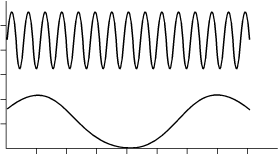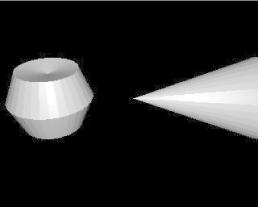Wireless networking is accomplished by sending and receiving radio waves between a transmitter and receiver. The theory behind RF data transmission can get very complicated and is outside the scope of this book. However, there are some basic concepts you should understand when you implement a WLAN.
A radio wave consists of electromagnetic energy. Visible light, television transmissions, and cosmic radiation are all forms of radio waves. Regardless of the type or purpose of the electromagnetic energy, these waves can be measured by several metrics. The frequency of a radio wave is how often the waveform completes a cycle in a given amount of time. The most common unit of measurement of frequency is the Hertz (Hz). A 1 Hz signal completes one cycle per second while a 10 Hz signal completes 10 cycles per second. Figure 1-1 shows the difference between the waveforms of a 10 Hz signal and a 1 Hz signal.
Generally, the faster the frequency, the more information you can transmit and receive. The method of encoding (or modulating) the data affects the amount that can be transmitted. Some encoding techniques are more resilient to errors but end up with lower data rates. Conversely, high data rate modulation mechanisms may be more susceptible to outside interference.
In the most general sense, the strength of a signal is the amplitude of its radio waveform. The unit of measurement of amplitude (or power) of a radio wave is a watt (W). WLAN devices typically transmit with a power of 30 milliwatts.
The strength of the signal decreases as it travels through its transmission medium—in this case, the air. This process of power loss is called attenuation. The amount of attenuation varies depending on the frequency of the signal and the medium through which it is traveling. Amplifiers can be added along a transmission medium to add strength to a signal.
The amount of power added due to amplification or removed due to attenuation is usually expressed in decibels (dB). Decibels provide a relative (logarithmic) measurement of signal strength. Each increase of three dB indicates a doubling in strength. Decibels are convenient because values can be added and subtracted from each other without need for complex mathematics.
While a signal is being received by a radio, the signal is also subject to noise at the same frequency as the signal. This noise may be due to environmental causes such as cosmic radiation or man-made reasons such as microwave ovens or even other radios operating in the same frequency. The ratio of the power of the received signal versus the power of the received noise is called the signal to noise ratio (SNR). The higher the SNR, the better the quality of the data signal.
Antennas are critical to radios sending and receiving radio waves. They turn electrical impulses into radio waveforms and vice versa. There are hundreds of different kinds of antennas, but they can be grouped roughly into two categories: omni-directional and directional.
The name omni-directional
implies that these antennas radiate electromagnetic energy
regularly in all directions. This is not the case. They usually
strongly radiate waves uniformly in two dimensions and not as
strongly in the third. These antennas are effective for irradiating
areas where the location of other wireless stations will vary with
time like an office with many laptop computers.
Directional antennas attempt to focus the radio waves into a more constrained area. Directional antennas lack the versatility of omni-directional antennas, however they are able to utilize their power much more effectively by only emitting energy where it is needed. Directional antennas are useful for fixed location installations such as a radio connection between two buildings. As a general rule of thumb, the higher the frequency of the wave, the more transmission can be focused using a directional antenna. Figure 1-2 shows the difference in radiation patterns between an omni-directional antenna and a directional antenna.
Sometimes antennas are deployed using diversity. Diversity is where a radio has multiple antennas attached to it. For a given signal, the radio decides what antenna it wants to send to and/or receive from. This allows the radio to adapt to propagation problems that may be affecting one antenna but not another. Many 802.11 PC cards have internal diversity antennas that make them more robust in hostile environments such as a typical office.
Get 802.11 Security now with the O’Reilly learning platform.
O’Reilly members experience books, live events, courses curated by job role, and more from O’Reilly and nearly 200 top publishers.



